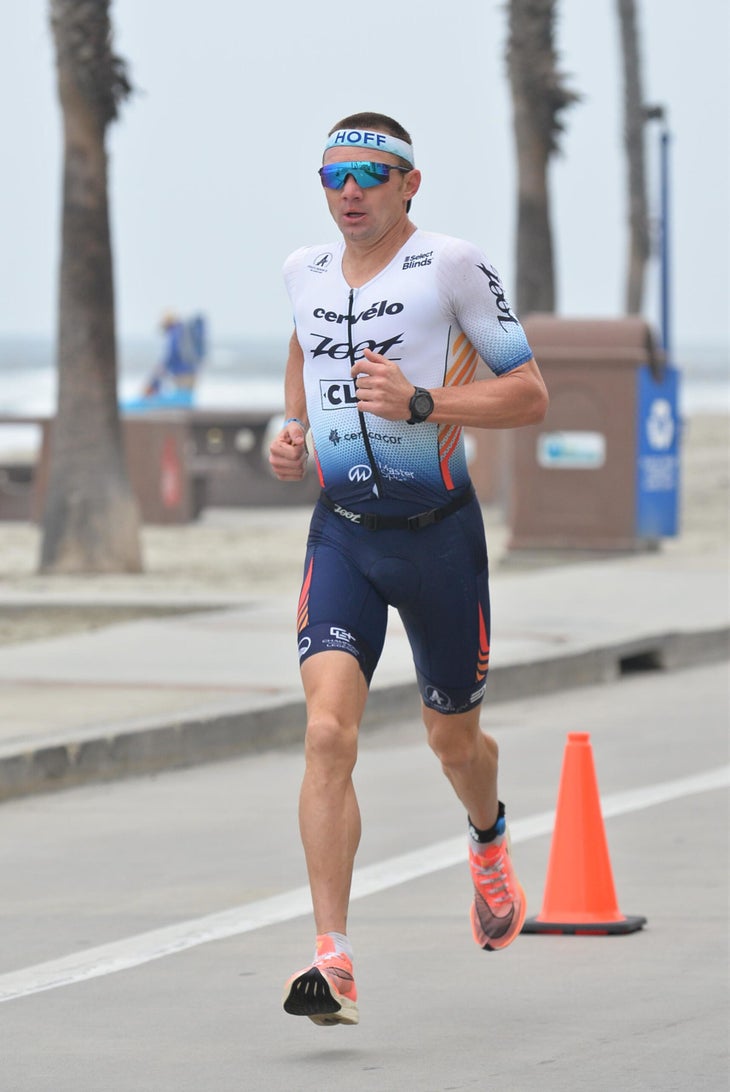New perk! Get after it with local recommendations just for you. Discover nearby events, routes out your door, and hidden gems when you sign up for the Local Running Drop.
Train 360 is our latest training column, designed to give you a deeper look at the many different aspects that go into a professional athlete executing a key workout. A key workout is considered a session that will yield significant fitness gains and is often positioned in a training program so that the athlete can hit it feeling relatively fresh and able to give it their all. As well as the key workout (which is listed in full below), there are many other factors to consider, including: “primer” sessions in the days leading in, activation and mobility exercises beforehand, fueling and nutrition (both before, during, and after the workout), mental preparation, and all of the gear and equipment involved. We’ve got it all outlined below from Ironman champion and Kona runner-up Ben Hoffman as he gives us the deep dive on his key long run session.
If you’d also like to check out the previous features in the Train 360 series, we looked at the FTP bike session of three-time Ironman world champion Mirinda Carfrae as well as Mel McQuaid’s “Aerobic Sandwich” bike session.
The Purpose
Hoffman said: “This is one of my key sessions that I repeat throughout the year, and throughout an Ironman build, and it’s an 18-mile run with some higher intensity and “quick start” tempo work. There are many parts to this workout and many factors to think about, but really the emphasis is on metabolic stimulus and race-specific neuromuscular development.”
The workout consists of a short warm-up of one mile, before going directly into a fast mile (at 30-45 seconds a mile faster than Ironman race pace). You then fall into 13 miles of tempo running at goal Ironman race pace, followed by another fast mile at 30-45 seconds a mile faster than Ironman race pace. You finish it off with two miles of easy aerobic cool-down for a total run distance of 18 miles.
“For me, the paces will vary based on the training cycle I’m in, but typically my warm-up pace is just under 7-minute per mile pace, fast miles are at 5:15-5:30-minute per mile pace, tempo is at 6-minute per mile pace, and cool-down is just under 7-minute/mile pace again.”
The main purpose of the workout is two-fold: Firstly, to force the body into sugar metabolism early in the run (with that higher intensity faster mile) and then be able to handle it. Secondly, it is to teach the body to establish a fast pace early in the run and hold it for the duration of the workout, just as you will need to in a race.
Hoffman’s coach, Ryan Bolton, said: “By running a mile hard early in the workout it almost immediately puts the body into sugar metabolism, which prematurely taxes the body and metabolism. This ‘tricks’ the body into thinking it’s later in the run than it actually is, which combined with a long ride the day prior better simulates Ironman run conditions.” He added that dropping into Ironman race pace after the fast mile is designed to train the body to hold that pace/rhythm while being in a taxed state.
“Ironman race pace is an aerobic zone,” Bolton said. “Ideally the body gradually shifts to fat metabolism again, allowing the body to hold that pace for a very long time. The final ‘hard’ mile is to simulate a need to push hard in the final phase of a race when very fatigued. Basically, it trains the body to drop someone late in the race, if necessary.”
He advised that this workout is typically done fairly late in Hoffman’s Ironman build and usually within four weeks of a big race.
RELATED: Fitter & Faster Podcast: Ryan Bolton on the Art of Coaching
The Workout
Warm-up
1 mile easy
Main set
1 mile fast @ 30-45 sec. per mile faster than Ironman race pace
13 miles @ tempo/Ironman race pace
1 mile @ 30-45 sec. per mile faster than Ironman race pace
Cool-down
2 miles easy
Total run: 18 miles
Note: If you’re looking for a scaled-back version of this, Hoffman’s coach Ryan Bolton, recommends the following: “I would definitely keep the fast mile at the beginning and the fast mile at the end. I would also shoot for similar time goals for all segments, but I would change the overall distance of the middle tempo section. I’d maybe drop that to six to 10 miles, depending on the strength and experience level of the athlete.”

The Day Before
“For me, there is no special preparation with regard to other workouts around this one, as I am typically a higher volume responder,” Hoffman said. “I recognize that this might not work for everyone, but I would normally do a longer, harder ride with a short run-off the day prior. There is usually a light swim to flush the legs after this run and I will also usually lift later in the day after the swim. This workout comes as part of a hard block of training, and the intention for me is not to enter the workout particularly fresh, but instead relatively fatigued.”
Note: For those athletes who aren’t higher volume responders, Bolton suggests going into this workout fresher than Hoffman would by cutting the duration and intensity of the ride/run the day before. A light swim post-run is ideal to help expedite recovery.
Gear
“I usually do this in one of my “faster” shoes, such as the Nike Tempo Next %, as the pace work is very much what I will be trying to hit in a race, and it certainly helps to have a little extra boost,” Hoffman said. “I wouldn’t consider this a total race shoe, but it’s very close. Otherwise, I use standard Zoot Ultra run training apparel, my custom race cap, and Oakley EV Zero Blades sunglasses. Depending on the time of the year, the shirt may come off halfway through!”
Fuel
As this is the first workout of the day for Hoffman, he said he always has a light breakfast beforehand of sourdough toast with almond butter and honey, a banana, and my cappuccino. He added: “Once the run is under way, I carry a couple of Clif gels (alternating between the Vanilla and the Mocha with caffeine) and some Clif Shot hydration drink mix (either the Cranberry Razz or Lemon Lime flavor) plus water to keep my sugar levels topped off and to simulate race fueling.”
Mental Focus Points
“I always think about trying to keep the tempo portion of this workout as smooth and controlled as possible,” he said. “Relax your shoulders, think of a string pulling your head up for good posture, slight forward lean, and efficient stride length. Engage your glutes and remain stable from side to side by utilizing your core, avoiding hip collapse.”
Pre-Workout Mobility
Mobility work is clearly important for Hoffman. He said: “Even for my easier runs, I do plenty of mobility and light warm-up exercises, but especially for this one. Things such as foam rolling, massage gun, and then band work to fire up my hamstrings, glutes, and adductors is key for me. I will also do some crunches to create some tension in my core.”
Post-Session Activities/Recovery
“Recovery is key to lock in the benefits of this workout, so post-run you will find me at the car with my Clif recovery shake, and then I’ll head straight home for a proper breakfast,” he said. “I will usually get a massage on Sunday afternoon, and I do light stretching and foam rolling later in the day after lifting. If I am tired enough, I will take a nap in my Rapid Reboot compression boots.”
RELATED: Spring 2021 Triathlete Buyer’s Guide: Recovery Tools
Coaching Points & Tips
So how does Hoffman recommend you tackle this workout? He said: “Set realistic pace goals for your fast miles and tempo, and then stick to them. It might feel easy to hit the first fast mile even faster, but it’s pointless if you can’t hold your tempo pace and then close the second fast mile while remaining in control. Ideally, you will have a way to carry some fuel or have someone support you, or you can create a looped course so you can fuel properly.”
He added: “Believe in yourself and stay positive. It might sound cliche and corny, but it works so much better than being negative. If you blow up during the attempt, you will still get something out of it, and I recommend finishing the miles (unless you are injured or truly risking it). Good luck!”
RELATED: Are You ‘You’ or ‘I’ When You Talk to Yourself During Workouts?
